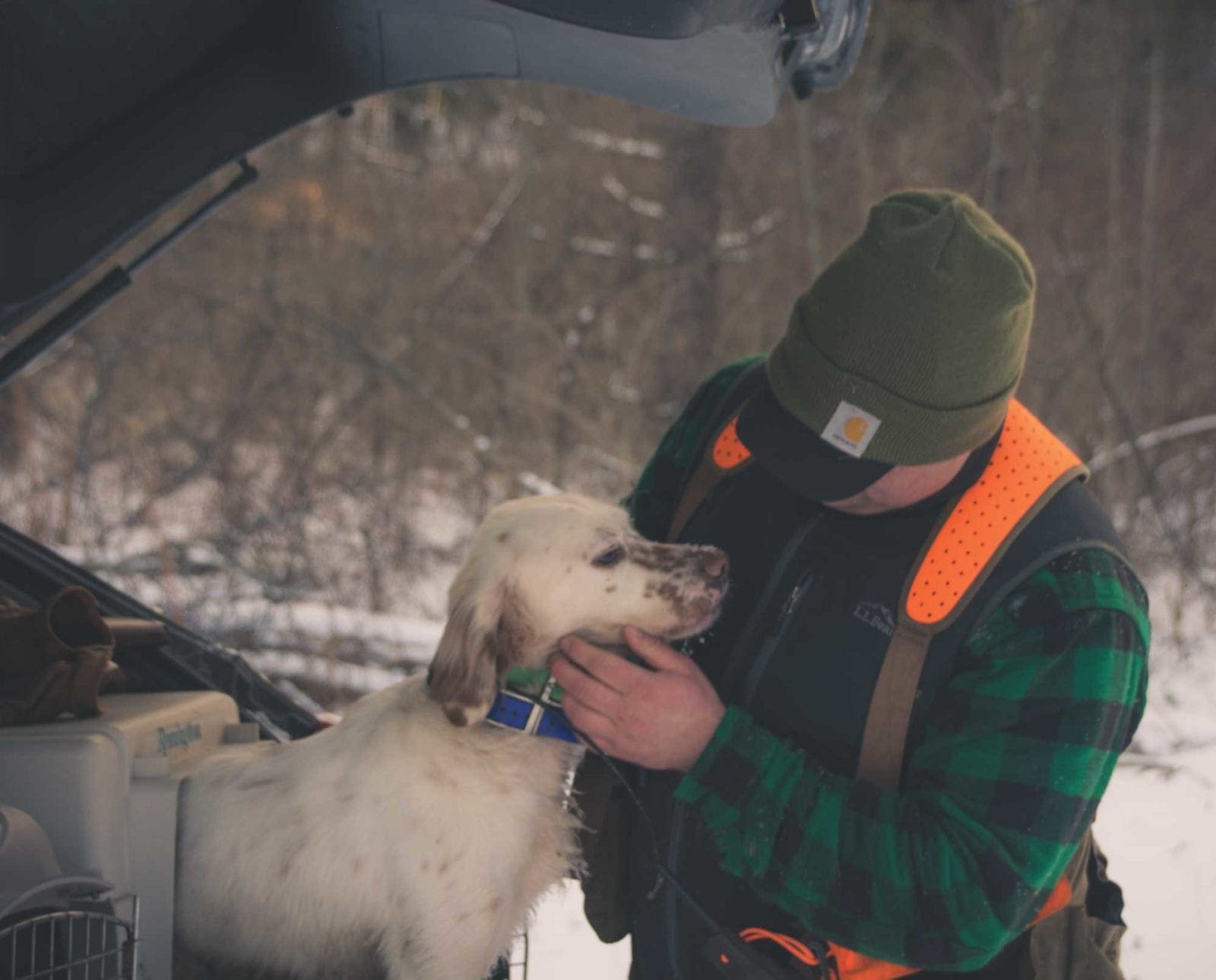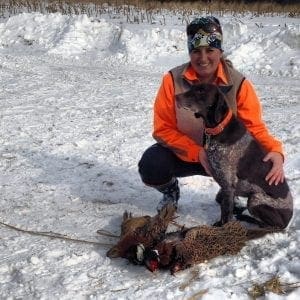Home » Hunting Dogs » How to Care for your Hunting Dog in Cold Weather
How to Care for your Hunting Dog in Cold Weather

Dr. Gracey Welsh is a small animal veterinarian. She splits…
Being prepared to care for your hunting dog when cold weather affects us in the field
Depending on where you are in the country, you might spend a lot of time in cold temperatures with your dog. If you don’t, you still might be one of those people who travels to colder climates specifically to work your dog there during the winter months. But as we’ve seen, especially this year, climates don’t always fulfill our expectations. And no matter where you are, cold conditions can get the upper hand on us. With this in mind, it’s important to be prepared—and this absolutely includes our dogs.
I remember a vivid afternoon (on Valentine’s Day…who doesn’t love a Valentine’s Day pheasant hunt?) where my husband and I took our dog Paisley out for a few hours. A couple feet of snow covered the ground and the temperature hovered around 10° Fahrenheit. The sun, however, was shining and we were going on a hunting date to take advantage of it. But a few hours into the hunt, our tough-as-nails German Shorthaired Pointer was starting to struggle, wobbling and slowing down. I will admit that we should have read the signs sooner before we asked her to carry on. Pretty soon, she was off lying down in a snowbank and wouldn’t get back up.
Her heart raced. She was dehydrated and hypoglycemic. Running her proverbial heart out through the deep snow, with the excitement of live birds, was too much for her that day. We had to carry her back to the truck through snow drifts, where finally some water, a snack, and a warm vehicle revived her. That day, I vowed to pay closer attention and to alway be prepared.
Your hunting dog’s age matters
Every dog responds to the cold differently. There are a number of factors that contribute to a dog’s ability to withstand cold temperatures or winter weather. Think snow, freezing rain, and howling winds. In general, these factors include breed, age, nutritional status, overall health, conditioning status and coat quality and type. Here’s an example. We know that our Labrador Retrievers are perhaps better suited for wetter and colder climates than our thin-coated Pointers. Extremes in age can also have a negative impact on an animal’s ability to thermoregulate in extreme environments. As a result, work requirements need to be tailored to the life-stage of the animal.
Conditioning in both the physical and nutritional form drastically improves a dog’s ability to reach its peak performance in cold weather. For our dogs, that generally means continuing to work them year-round in order to preserve muscle mass. Feeding them adequately means they’ll have the right amount of fat storage to utilize in colder temperatures.
Again, each individual dog’s needs determines what this looks like. Owners who have dogs that spend a lot of time in the cold may find that food requirements increase with the cold. A veterinarian well-versed in the nutritional needs of working dogs will be able to outline the ideal feeding plan for these dogs.
If a dog is not acclimated and the hunter is not prepared, hypothermia becomes a real risk for your dog
We don’t have a lot of data to look at in terms of how long it takes a dog to ‘acclimate’ to a certain temperature. That being said, it’s pretty certain from what we know that acclimation is not going to happen over the weekend. Only repeated exposure to a certain temperature, at progressively increased lengths of times, can do that.
Signs of cold intolerance in our hunting breeds usually include: shivering, refusing commands, decreased efficacy of the task at hand, and refusing to carry on. Many dogs shiver when they’re cold. This can progress to the dog picking up a single limb intermittently or sitting down and refusing to continue. Decreased olfaction results from constriction of vessels in the nasal passages as a result of lower temperatures. You may notice a dog over-running birds. Dogs housed in kennels may refuse to come out of their area. A dog that is normally jumping at the gate will be hunkered down inside.
True hypothermia (a body temperature of less than 99°) is a life-threatening situation and requires immediate veterinary attention. The first sign is a general weakness that affects mental activity. A few scenarios can result in this. It might be because the owner is mistaken or improperly prepared. This is the kind of person who might get lost in the winter, wander off the trail, or lack the supplies to spend a long duration outside. Some owners fail to recognize the signs of cold intolerance in their dog and push them beyond their limit.
Falling through ice into cold water is another risk factor. Most often, however, another injury or illness has changed the way a dog compensates for temperature change. This is why I urge everyone who has a dog that is acting abnormally in the cold to suspend activity. Protect the dog from the elements and seek veterinary care as needed. In these cases, it’s always better safe than sorry.
There are various steps an owner can take to protect their dog in the cold. The first would be to teach a dog to wear booties or a vest/coat. Booties protect delicate paw pads from ice and snow build up. Additionally, a vest or coat reflects heat internally. Some dogs are taught to wear boots from puppyhood and transition very nicely to wearing them each day as adults. However, many of you may have seen the hilarity that ensues when asking an adult dog to don a pair for the first time. A video of this makes for a great youtube work break.
In cases where dogs refuse to wear booties, there are various products that can be applied to protect the pads. I am a fan of a product called Musher’s Secret, which is applied to the paw pads and between toes before an outing. Vaseline or bag balm work similarly. I advocate wiping it off before returning dogs indoors or to their kennels, so you avoid the dog ingesting a large amount. There are many commercial dog coat products available to help dogs retain heat.
The cold can still be a threat even if your dog handles It well while working
Conversely, if the dog is working at a good pace and the temperature is only moderately cold, it’s unlikely that the dog needs a coat. In my opinion, with the qualification that it depends on the dog, moderate cold is above 0°. It should be noted that working dogs in cold weather are always at risk of dehydration. This is because their muscles have to work hard at producing enough heat to thermoregulate and propel them through the environment. Regular water intake during winter work is therefore essential.
I think the most common mistake I see made with dogs in cold weather comes after the activity is over. Problems arise when you take a steaming dog straight off the ground and place it into a kennel. The dog will continue to generate heat internally, producing moist air in the kennel, most of which are insulated in the winter months. As the dog starts to cool off, they quickly become cold and wet. Many of us have experienced this personally when sitting around too long in our long underwear after a good outdoor workout. You can start to develop cold chills.
After running in cold weather, a proper cool-down for five minutes is key. Slow the walking, have a drink of water. Perform a few tailgate stretches to give the body enough time to exhaust this extra heat build-up. I then recommend wiping off your dogs with a dry, absorbent towel.
Kennels should be bedded down with clean, dry bedding. Many prefer straw, but fresh towels or commercial kennel mats also do the trick as long as they are monitored for moisture between outings. It is ill-advised to run a dog twice during a cold day without them coming indoors to warm up for a sufficient amount of time. Switching dogs in-and-out of the truck kennels on a cold day is a recipe for discomfort. If the body doesn’t get a chance to normalize, the dog is at risk for hypothermia, muscle injury, and decreased mental acuity.
There are many dogs who live outdoors year-round and do very well with it. These dogs likely acclimate to temperature changes and extremes. Yet, I still believe that some precautions should be taken for these dogs. Dry, clean bedding in an area protected from the elements ensures that the dogs are kept warm even in the coldest temperatures.
Know what to look for and how to read the signs when spending time with your dog in the cold
We learn a lot about cold weather protection from our colleagues in the sled dog world. They watch out for precipitation build-up on a dog’s coat. If you see snow staying as snow on the coat, this indicates that the coat is properly insulated. Alternatively, if the snow melts and turns to ice on their coat, it means that the dog is losing excessive heat and their coat is not insulating well enough. These dogs should be wearing an insulated protective layer like a vest. If not that, then they should at least have access to a dry and warm enclosed space.
There are a few other common sense practices to avoid cold-related problems in our dogs. Placing a thermometer in the dog kennel, or wherever the dogs lives, is an easy and helpful monitoring tool. I am a big fan of insulated kennel covers. I personally use the Mud River insulated product and have been very happy with that.
Of course, close attention to the dog’s behavior when working is paramount. If your dog is acting even the littlest bit off in the cold weather, then suspend the activity and bring them inside to warm up. Letting a dog go too long can push you too late in the safety game. If in doubt, pull your dog off the ground and head home. Risking your dog’s life over one day’s work doesn’t seem worth it to me. Most dogs are really good at giving signs that they are uncomfortable in the cold, if we just pay attention to them.
Finally, commit to effective preparation. Ensure that your dog is in tip-top shape before embarking on a winter trip. Prepare for your trip by carrying (on your person) the necessary items that will help stabilize your dog in the event of injury. This includes blankets or coats. Always be prepared to be out in the cold longer than intended. There are many programs out there that teach winter preparedness for people. Many of those ideas can be modified to protect our dogs, too.
Advice in this article is meant to help educate and prepare you, but should never substitute for a veterinary examination. If you are concerned about something with your dog, please visit your veterinarian. This article is about taking care of your gun dog in cold weather.
Dr. Gracey Welsh is a small animal veterinarian. She splits her practice time between general practice in Lake Placid, NY and emergency work in Williston VT. Her professional interests include working dog nutrition and conditioning. Outside of work she loves spending time with her husband and their three dogs (two german shorthairs and one english pointer) in the woods--be it hunting season, summer training or winter skijoring. You can contact her at dr.gfwelsh@gmail.com or follow her pointer crew on their adventures on instragram @points_north




